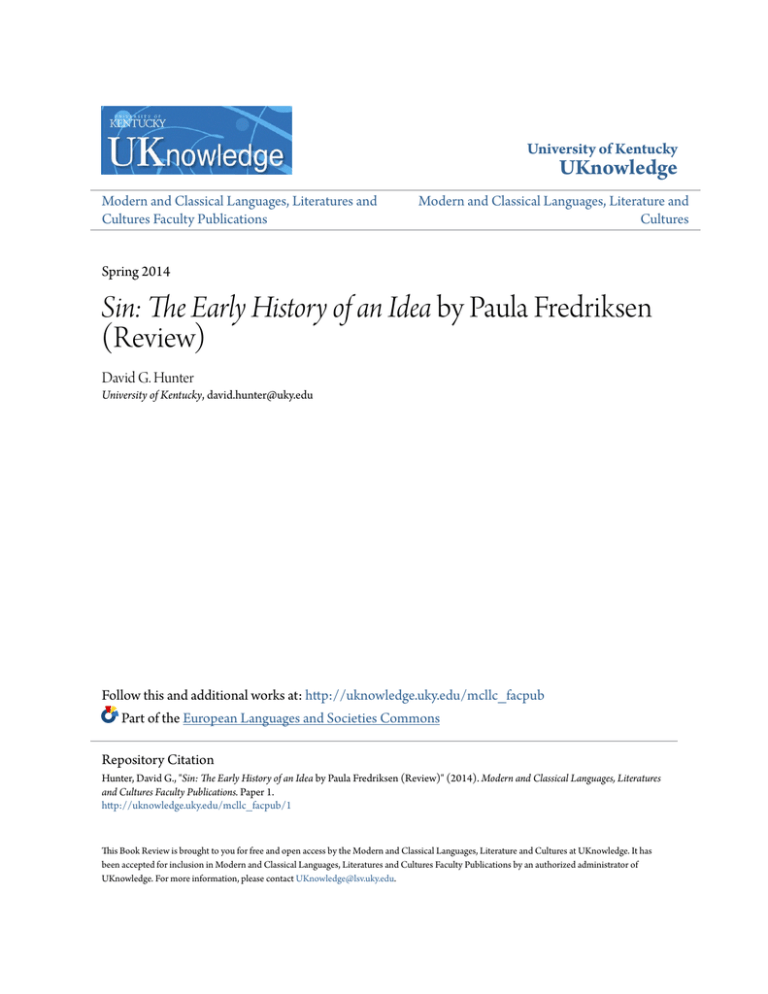em>Sin: The Early History of an Ideaem> by Paula Fredriksen
advertisement

University of Kentucky UKnowledge Modern and Classical Languages, Literatures and Cultures Faculty Publications Modern and Classical Languages, Literature and Cultures Spring 2014 Sin: The Early History of an Idea by Paula Fredriksen (Review) David G. Hunter University of Kentucky, david.hunter@uky.edu Follow this and additional works at: http://uknowledge.uky.edu/mcllc_facpub Part of the European Languages and Societies Commons Repository Citation Hunter, David G., "Sin: The Early History of an Idea by Paula Fredriksen (Review)" (2014). Modern and Classical Languages, Literatures and Cultures Faculty Publications. Paper 1. http://uknowledge.uky.edu/mcllc_facpub/1 This Book Review is brought to you for free and open access by the Modern and Classical Languages, Literature and Cultures at UKnowledge. It has been accepted for inclusion in Modern and Classical Languages, Literatures and Cultures Faculty Publications by an authorized administrator of UKnowledge. For more information, please contact UKnowledge@lsv.uky.edu. BOOK REVIEWS 155 Paula Fredriksen Sin: The Early History of an Idea Princeton, NJ and Oxford: Princeton University Press, 2012 Pp. vii + 209. $24.95. The work of Paula Fredriksen has long been familiar to readers of this journal. She is that rare scholar who seems to be comfortable working both in the literature of the New Testament and Second Temple Judaism, as well as in patristic texts. Her contributions to Augustinian scholarship, for example, have ranged from her study of Augustine’s early commentaries on Romans to the more recent Augustine and the Jews. In between she has produced foundational work on the historical Jesus and on Christian anti-Judaism. The present volume, based on the Spencer Trask Lectures delivered at Princeton University in the fall of 2007, weaves together elements from several of these studies around the central theme of sin. The result is a short, but rich, set of historical reflections on a wide range of figures from Jesus to Augustine. Fredriksen deliberately chooses to focus on diversity, emphasizing “those moments that represent evolutionary jumps—points of ‘punctuated equilibrium,’ as evolutionary biologists say” (4). She discusses seven characters in three chapters: Jesus and Paul (chapter one, though some attention is given to John the baptizer as well); Valentinus, Marcion, and Justin Martyr (chapter two); and Origen and Augustine (chapter three). Focus on these “disjunctures” has its advantages, because it enables Fredriksen to respect the very different contexts of the individual figures. She rightly stresses the thoroughly Jewish and apocalyptic outlook of Jesus and Paul, although they addressed very different audiences (Jewish and gentile). Both men had deep respect for the temple cult and used language and imagery from the temple to articulate their own notions of the mechanisms of redemption. Jesus, she argues, used “the temple, its biblically based protocols of sacrifice, and its function as a place of atonement offerings for the forgiveness of sin” in order to sum up his own mission at the last supper (22). And Paul characterized his own work among the gentiles as that of a “priest’s assistant” (leitourgos) bringing the gentiles as a sanctified offering to Jerusalem (Rom 15.16), together with Christ as priest/cohen (37–38). Fredriksen argues convincingly that neither Paul nor Jesus rejected temple worship or denied its efficacy for Jews, including Jewish believers in Jesus. Chapter two turns to the second century and the work of Valentinus, Marcion, and Justin. Like many modern scholars, Fredriksen is more enamored of “diversity” than “orthodoxy” or “proto-orthodoxy.” Unfortunately, her discussion of these second-century figures, while not inaccurate, is presented within a framework that borders on the polemical. For example, she begins a discussion of secondcentury diversity with these remarks about Constantine and the fourth-century bishops: “He threw his prestige, his authority, and a good deal of publicly funded largesse behind one sect of the church, in effect empowering its bishops to suppress their rivals. Thus began a new stage in the empire’s persecution of Christians, this time pursued by Christians themselves” (62). By banning and burning the texts of “deviant” Christians, “the bishops got to remake the Christian past in 156 JOURNAL OF EARLY CHRISTIAN STUDIES their own image . . . . The record of the Christian past, in short, was effaced by the church itself” (62–63). It is not clear to me that these comments shed much light on the teachings of Marcion or Valentinus; moreover, they give the (false) impression that “deviant” forms of Christianity flourished happily in the second and third centuries until they were suppressed in the fourth century by those power-hungry bishops. It is true that the legal suppression of “heresy” begins in the (later) fourth century, but there was an extensive tradition of anti-heretical writing by pre-Constantinian Christians (Irenaeus, Hippolytus, Tertullian, et al.) that goes virtually unmentioned here. Likewise, when Fredriksen does mention the tradition of anti-heretical writing, it is only to dismiss it as historically unreliable: “Heated polemic rarely yields reliable description” (67). The stories told about Marcion and Valentinus by proto-orthodox writers are “good rhetoric” but “bad history.” It is true that polemical sources must be used cautiously, but several pages later (72–73) Fredriksen herself relies on Irenaeus’s account of the Aeons in Adversus haereses in order to characterize the system of Valentinus. Apparently the “heated polemic” of Irenaeus was sometimes capable of yielding “reliable description.” At several points she refers to the Letter to Flora by Ptolemy but fails to note that this was preserved by one of those pesky fourth-century bishops, Epiphanius. Apparently, they did not entirely efface “the record of the Christian past.” The point is that Fredriksen’s own polemical rhetoric sometimes obscures her own good history. Fredriksen is on firmer ground in her third chapter, which presents a solid overview of the similarities and differences between Origen and Augustine on issues such as creation, materiality, sin, and redemption. She helpfully contrasts their respective views on God, history, and the interpretation of Scripture. Even here, however, there are some odd slips. On page 112 it is stated without qualification that Augustine “had been a married man.” It is certainly true that his thirteen-year relationship with the mother of his son would have been regarded as a kind of “marriage” in some circles. But it was not coniugium iustum or a legal marriage, nor did Augustine himself regard it as one. Augustine’s famous story of the theft of pears is not set in his twelfth year (148), but in his sixteenth (Conf. 2.2.4: anno illo sexto decimo aetatis carnis meae). But these are minor matters that do nothing to detract from the work as a whole. In short, Fredriksen has accomplished a difficult task: to produce a highly readable and accessible survey of early Christian thought, one that discusses much more than the specific topic of “sin.” Most patristic scholars will be familiar with most of the material here, but Fredriksen’s synthesis is her own, and it is worth reading. Moreover, the book will be a useful resource for non-specialists, including college students, in need of a reliable account of the diversity of ancient Christian theology. David G. Hunter, University of Kentucky




